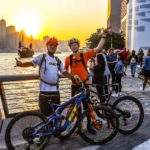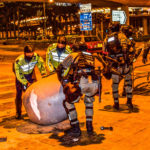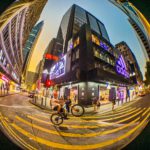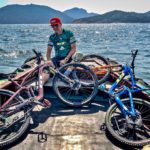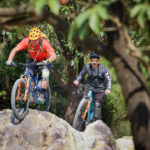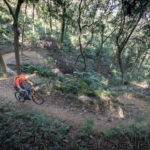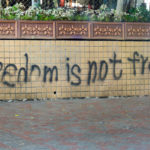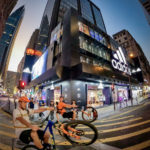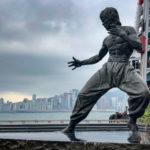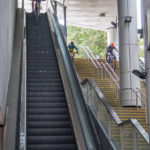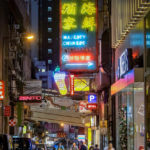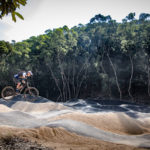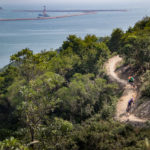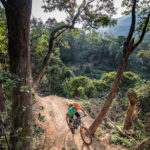Hans Rey and top Enduro racer Martin Maes explore Hong Kong in a 5 day urban adventure during turbulent times. Not only to showcase this amazing city with its 7000 high rise buildings, but also its beautiful nature and purpose built bike trails surrounding the city and islands. It’s a wonderful journey of contrasts; nature and harmony versus urban jungle and chaos, culture and history.
Trans Hong Kong
An Urban Mountain Bike Adventure with Hans Rey & Martin Maes
Story by Carmen Freeman-Rey
Photos by Bill Freeman and Carmen Freeman-Rey
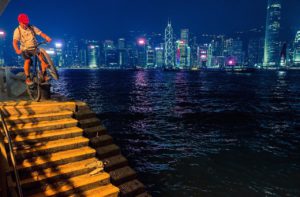 Hong Kong is a place of many faces, a conurbation that is much more than the island from which it derives its famous name. There are sprawling masses of habitation, most stretching high into the sky and then the contradiction of the outlying islands that offer up for the most part, a different more peaceful way of life, this city is full of opposites.
Hong Kong is a place of many faces, a conurbation that is much more than the island from which it derives its famous name. There are sprawling masses of habitation, most stretching high into the sky and then the contradiction of the outlying islands that offer up for the most part, a different more peaceful way of life, this city is full of opposites.
This story is about Trans Hong Kong, the third in a series of films that capture Hans Rey exploring both the natural and urban environments of iconic cities around the world on a mountainbike. There are not many places as instantly recognizable as Hong Kong, the skyline cluttered with monolithic buildings, green mountains and islands. Some would say the same about Hans, after over 30 years as a pro extreme MTB rider, one of the Freeride pioneers, adventurer, his early films paved the way for today’s YouTube generation.
It was, after months of planning that our international team finally touched down in Hong Kong. Media, friends and family had made us question the potential folly of coming here at this point in time to make a film and photo story. November 2019 saw a ramping up of discord in the social climate, happening since the summer. Scrapping our plans was not really an option, all that planning would have been wasted and too many people let down. We set off understanding that there could be potential roadblocks along the way and we would have to be flexible, adaptable to altering our schedule instantly if and when events unfolded.
Flying into the new international airport Chek Lap Kok, sited on a small man made island attached to Lantau Island was not as dramatic as landing at the infamous Kai Tak of the old days. One feels relieved for the people that are no longer subjected to jets buzzing their balconies, as laundry dried flapping on bamboo poles like some modern day joust.
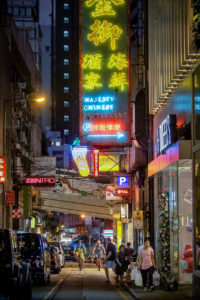 The first day was met with an energetic Hans, eager to hop on his bike after such a long journey and ride the epic Tin Man trail located in the New Territories region. There are still large areas in Hong Kong that have not been urbanized and are preserved as country parks for the locals and visitors to enjoy.
The first day was met with an energetic Hans, eager to hop on his bike after such a long journey and ride the epic Tin Man trail located in the New Territories region. There are still large areas in Hong Kong that have not been urbanized and are preserved as country parks for the locals and visitors to enjoy.
The population of Hong Kong Island and Kowloon grew rapidly, more homes were needed, therefore urban developments spread up and out, from Kowloon to the north all the way to the border with mainland China, south and southwest to the islands of Lamma and Lantau. There are 7.5 million people living in Hong Kong and 50% of them reside in the New Territories. Hans would be sampling a few of the trails that this region has to offer, the first being Tai Mo Shan, which has the highest peak at 957m. Hans teamed up with Hong Kong native Tiger; a local ripper who grew up watching Hans’ videos. He races on a local level and runs a bike repair shop from his small apartment. Together they rode the network of purpose built trails, some specific for mountain bikers and others dual use. From Tai Mo Shan they headed north and then swung to the west traversing the New Territories and edging closer to mainland China on the Ho Pui Contour Trail. The riding was super fun, not too technical and not to steep, only requiring intermediate skills for the most part, suiting many levels of rider. They rode through miles of sub-tropical vegetation, canopies of exotic looking plants, bamboo groves, streams and waterfalls. The temperature was perfect with a very tolerable level of humidity and the sky was a clear azure blue, perfect for the Trans Hong Kong Urban Adventure. Hans and Tiger continued on towards the west coast finishing their journey on Tin Fu Tsai, “Tin Man”, or as the locals call it “Yuen Long Tsai”. We discovered that there is quite a mountain biking scene in Hong Kong and this is possibly its most popular trail, over 1,400’ of descent on a super flowy run with packed dirt and bedded rocks to help you glide over the areas that might be a bit wet and boggy.
The day had unfolded in an environment that was both rural and peaceful, day two would be the opposite; Hans would be exploring Kowloon and he would be joined by Martin Maes, one of the world’s top Enduro and Downhill racers from Belgium.
Kowloon covers a huge area. Once upon a time it was all about the old international airport, the planes flying so low as they came into land that you could look into the apartment windows, people had little privacy or peace. The Peninsula hotel was closer to the sea front, this being about the only posh place in Kowloon. The streets were a maze of shops selling discounted electronic equipment and street markets stacked with everything from dried fish to disposable tat; these came especially alive at night. The homes were tightly packed grey shabby towers.
Now parts of Kowloon give Central a run for its money. The airport has been moved away to a new location, the harbor and sea front has been transformed with glitzy buildings, rising tall and bright mirroring the reflection of the super yachts bobbing on the water. The sea has been pushed back with made up land to make Kowloon a little bigger, it now has a promenade and the Avenue of the Stars.
Here the money has moved in, banks, insurance companies, elegant shops and swanky hotels. The jewel in the crown has to be the Ritz Carlton at the top of the International Commerce Center; this is the tallest building in Hong Kong standing at 1,588’.
Our second day would begin with riding to what is possibly the most spectacular viewpoint in all of Hong Kong, Suicide Cliff. From the top you have a 360-degree view encompassing Tai Mo Shan, Victoria Harbor, Kowloon, Hong Kong Island, Lantau Island and Shenzhen (mainland China), quite a list.
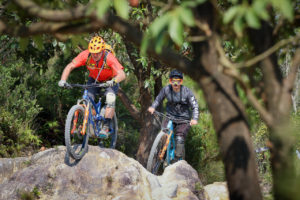 This is not called Suicide Cliff because people jump to their deaths, but rather because unless you are an expert; to hike/climb is considered suicidal. Some of the trail was not only overgrown but the tropical plants were, in places taller than Hans and Martin, creating an umbrella of leaves, providing temporary shelter from the sun. This ascent could not be ridden, instead it was an exhausting and treacherous near vertical hike a-bike-up a narrow track to reach the saddle where riding was again possible. Everyone was more exhausted than they expected by the end of the climb and pretty dehydrated; tip, take 2 liters of water for this excursion.
This is not called Suicide Cliff because people jump to their deaths, but rather because unless you are an expert; to hike/climb is considered suicidal. Some of the trail was not only overgrown but the tropical plants were, in places taller than Hans and Martin, creating an umbrella of leaves, providing temporary shelter from the sun. This ascent could not be ridden, instead it was an exhausting and treacherous near vertical hike a-bike-up a narrow track to reach the saddle where riding was again possible. Everyone was more exhausted than they expected by the end of the climb and pretty dehydrated; tip, take 2 liters of water for this excursion.
Along the way we came across a number of hikers, locals and visitors, but no one was insane enough to be on a bike, they were all intrigued when they saw Hans and Martin riding along the rocky incredibly technical ridge, passing Kowloon Peak radio towers and down the death defying exposed plunge to Suicide Cliff. Hans was riding his GT Force, a tough all mountain bike, with big travel, the suspension sucks up the rocks providing more cushion. Martin was on a GT Sensor, more of an all trail mountain bike, a little less suspension, but with the benefit of being lighter on those climbs and 29” wheels that provide extra roll and speed.
We knew from photos that the view would be spectacular, but they didn’t prepare us for the jaw dropping wow factor. As we crested the final peak that looked down on to Suicide Cliff, we all felt an adrenaline rush and were rendered somewhat speechless.
This rock that juts out dramatically and is accessed so precariously via a narrow exposed trails littered with loose rocks is possibly the number one hotspot in Hong Kong for the selfie-obsessed to pose and click. It was amazing how many millennials there were perched on the edge taking pictures of themselves, over and over again. Clearly this is a serious and dangerous past time for the Instagram generation. From this vantage point one can get a broader perspective of the diversity of Hong Kong, the skyscrapers and high rises crammed in one after another, the log jammed traffic passing like ants below, the harbor with the cargo ships and super yachts, the port with crane upon crane and containers stacked up like bricks in a wall, but also the beautiful greenery of the scattered islands spread out before us like emeralds in the sea.
It was time to make our descent and head back to the city, dirt made way for tarmac and stairs. We dodged the crowds as we made our way through street markets, discovered the delights of a tucked away bakery for a midday snack and came across curiously constructed apartment buildings built as squares with central courtyards offering little light since the quad extended up to approximately 40 floors. In this dark and dirty space groups of women sat on sheets of cardboard or old blankets, huddled together and chatting. They were the maids that worked in the building surrounding them; this was their break and the only place they could gather to relax. The apartments looked somewhat formidable, every door and window painted a uniformly green and each one covered with metal bars. It was explained to us that this was not a bad place to live, it was considered a step up from many.
 Housing is a situation in Hong Kong, this is a densely populated place and a lot of residents are poor, there is a huge income disparity here. HK has more wealthy individuals than any other city in the world, one in every 110,000 is a billionaire, but there are many more that struggle living here. Because of this, it is not uncommon for multiple generations to share an apartment and to take turns using a bed, sleeping in shifts. For example, the grandparents would sleep in the day when the generations below them are at work or school.
Housing is a situation in Hong Kong, this is a densely populated place and a lot of residents are poor, there is a huge income disparity here. HK has more wealthy individuals than any other city in the world, one in every 110,000 is a billionaire, but there are many more that struggle living here. Because of this, it is not uncommon for multiple generations to share an apartment and to take turns using a bed, sleeping in shifts. For example, the grandparents would sleep in the day when the generations below them are at work or school.
We continued on following the road all the way downhill to the water, with one eye over our shoulders ever conscious of the crazy traffic. Sometimes we rode the subway stairs going underground and sometimes took the escalators up to the bridges that allowed safe passage from block to block. Hans and I had been to Hong Kong before and knew what to expect when first faced with the view of Victoria harbor from the Kowloon side looking across to Hong Kong Island with all its skyscrapers. It is spectacular and Martin seeing this for the first time was obviously most impressed, stating, “this is the most amazing city I have ever seen”.
All kinds of people were strolling along the promenade, some would stop and gape, then grab their cameras to take a shot as Hans and Martin pulled long wheelies as they rode by. These were soon replaced with selfie-sticks, if they could be in the shot too, why not?
The sun was setting on another day with mirrored buildings reflecting the high rises, water, yachts and junks all ablaze with a golden glow. The sun sunk below the structures on Hong Kong Island and day turned to night the skyscrapers lit up with dazzling, vibrant colors of every hue. The night sky offered us an iridescent almost full moon and Hong Kong gave us a city of saturated lights.
Time to switch up the pace again and head back to the bright neon lit signs of Kowloon that offered us things to buy that we could never understand. The city doesn’t dampen down with the fall of darkness, if anything the energy level ratchets up. This truly is a city that never sleeps. We headed into the more salubrious shopping district in Kowloon, short cutting through alleyways and charging down avenues, a bike is a fun way to see the city and although the volume of traffic was crazy, it never actually felt dangerous. Hans and Martin managed to get a ticking off for riding through an Adidas mega store, but I think the staff liked it really. Martin was hungry; Martin hungry is not a happy person, food was necessary and some of the best places to eat in Hong Kong are at cooked food indoor markets. Put simply, there would be a large floor area, somewhat utilitarian in appearance with very harsh florescent lighting and a variety of kitchens. The seating for diners is communal and basic, nothing glamorous about this experience. But ohhhh…..the food! It is so delicious that they have no need to dress it up with mood lighting and fancy décor. We ate and ate; one dish after another arrived as we shared family style. Bellies full it was time to head to bed and rest up for our next day which would find us riding the epitome of Hong Kong contradictions.
The sun rose on day three and it was time for some island life. We headed off to Lantau, south west of Hong Kong and attached to the mainland via a causeway, Lantau is home to Disneyland Hong Kong, the new (ish) international airport, the Ngong Ping 360 gondola and Tian Tan, one of the largest bronze Buddhas in the world. Here are also some top trails, built with some collaboration from IMBA and under oversight from HM from DirTraction and other local bike associations. The trails are extensive, covering quite a distance, crisscrossing the island. There is a newly built bike park featuring a beautiful asphalt pump track. The highlight of the day was 18 km Chi Ma Wan trail, which has recently been extended.
It was a pleasure watching Martin Maes ride, he has a style that floats and skims along the trails, he is so at ease and fluid on the bike, Martin has a serious amount of talent. He has EWS wins under his belt as well as a World Cup DH 1st and 2nd in DH World Championship for GT Bicycles. Martin has achieved so much already and he is still young, we know that his multiple skills will take him ever farther on the world race circuits. If you want to ride mountain bikes in Hong Kong, Lantau is a must and to get there with mountain bikes, the best way to go is with a Go Go….van.
 Another dawn and a new day, this time we would be exploring the urban jungle and some nature on Hong Kong Island and we were anticipating another mega watt view. As planned we met up with Nick Dover our British ex-pat “fixer” beside the Bruce Lee statue on the Avenue of Stars. We crossed from Kowloon to the Central district, Hong Kong Island on the famous Star Ferry; this is an iconic alternative way to go to and fro and very much a part of the island’s history and identity. We left the peninsula behind as we motored, bobbing across Victoria harbor coming ever closer to those awe inspiring tall buildings that we saw lit up before.
Another dawn and a new day, this time we would be exploring the urban jungle and some nature on Hong Kong Island and we were anticipating another mega watt view. As planned we met up with Nick Dover our British ex-pat “fixer” beside the Bruce Lee statue on the Avenue of Stars. We crossed from Kowloon to the Central district, Hong Kong Island on the famous Star Ferry; this is an iconic alternative way to go to and fro and very much a part of the island’s history and identity. We left the peninsula behind as we motored, bobbing across Victoria harbor coming ever closer to those awe inspiring tall buildings that we saw lit up before.
After disembarking we made our way along the steep streets up to the famous Victoria Peak, which stands at a majestic 1,800’ high, The Peak is home to some of the most exclusive and valuable real estate in the world, it is cooler up there, very private and the views of Hong Kong’s Central District and Kowloon are spectacular with its iconic buildings such as the banks of China, HSBC and the International Commerce Centre. The harbor waters were laid out before us, the distant islands popped vividly in the blue sea. This mountain is incredibly steep and a jungle of bushes, many people access the The Peak via the funicular tram that has been there since the late 1800s and services approximately 11,000 people a day. For Hans and Martin there was no alternative but to ride the road back to the city, hammering a few more staircases along the way. We were headed to Hollywood Road and Soho via another street market, this one specializing in food, every seafood, vegetable and colourful exotic fruit imaginable. The food was so fresh, in the case of the shellfish, a little too fresh with the langoustines jumping and flapping about, some landing at our feet.
Hollywood Road is the second oldest in Hong Kong and was built before the famous Hollywood in California, it is known for its eclectic shops, antiques and art galleries. As we rode through the streets, the absolute juxtaposition of Hong Kong was glaringly apparent, one moment we are in the land of billionaire properties and looking down on the 1,500 architecturally astounding skyscrapers and then we are navigating around the crowds jammed into tight streets lit with neon signs haggling over the price of fish heads.
From Hollywood we pedaled on to the Soho District, which is famous for its seriously long escalator system, it acts similarly to funicular railway by taking pedestrians up higher and higher on very steep streets with exit points at each road intersection. This used to be the longest escalator system in the world. Soho once consisted of mostly residential flats and offices, over time shops, bars and restaurants moved in creating a lively buzz at night. This highlights another example of traditional melding with the new and modern.
Nick the fixer had us install an app that showed in real time where the protest flare up points were. The hot spots were illustrated with cartoon dinosaurs, or raptors as they were referred to. The app was immensely useful. While there public transport was a struggle, the metro being shut down for periods, buses not always running, taxis going undercover and the Star Ferry temporarily ceasing service. It was all very unpredictable. With the app we could avoid the flare-ups and not get stranded. Or so we thought. After a brief pit stop for dinner it was decided to head back to the hotel, we could hear the cacophony of clanging and raised voices coming from the streets ahead. Bricks were being dug up from the roads and thrown, trashcans and trees upended and tossed aside. In front of us a swath of people, many masked or clutching umbrellas suddenly turned and ran in our direction yelling at us to “run, run” as the acrid stink of tear gas reached our nostrils and the sting hit our eyes and throats.
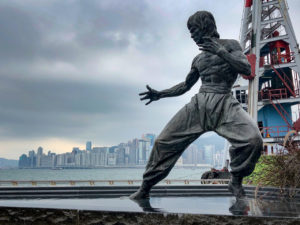 It would be strange to write a story about being in Hong Kong in November of 2019 and not write about the protests. We did experience being in the thick of it, at one point I was on the front line and can confirm that it was intimidating to see helmeted armed police with riot shields up, holding a line or marching in formation whilst protestors shouted and chanted at the top of their voices. As surreal as this scene was, something like a dystopian scene from a Ridley Scott movie, this was no fantasy this was real and a shocking. As we continued on we saw broken glass, evidence of smashed shop fronts, the relentless screech of the sirens shattered the night. However somewhat bizarrely many people acted as though nothing amiss was happening, some jogging the streets or sitting at a café just around the corner from the action, even slack-lining on the other side of the boulevard by the Star Ferry. This week saw protests all over Hong Kong, turmoil and unrest, it could be that we were witnessing historic change, that perhaps Hong Kong would never be quite the same again.
It would be strange to write a story about being in Hong Kong in November of 2019 and not write about the protests. We did experience being in the thick of it, at one point I was on the front line and can confirm that it was intimidating to see helmeted armed police with riot shields up, holding a line or marching in formation whilst protestors shouted and chanted at the top of their voices. As surreal as this scene was, something like a dystopian scene from a Ridley Scott movie, this was no fantasy this was real and a shocking. As we continued on we saw broken glass, evidence of smashed shop fronts, the relentless screech of the sirens shattered the night. However somewhat bizarrely many people acted as though nothing amiss was happening, some jogging the streets or sitting at a café just around the corner from the action, even slack-lining on the other side of the boulevard by the Star Ferry. This week saw protests all over Hong Kong, turmoil and unrest, it could be that we were witnessing historic change, that perhaps Hong Kong would never be quite the same again.
Our final day could not have been more different than the one previously, hopping onto the MTR, taking the underground to Aberdeen Harbor and hiring a local fisherman to take us in a Sampan across the Lamma Channel for the final stage of Trans Hong Kong. It was eventful; we came within a berth of a huge cargo ship and trusted that our skipper knew exactly what he was doing.
As we came into Pichic Bay it was already evident that this place was very different. There were colorful houses and cafes perched on stilts by the edge of the emerald waters, scattered with pontoons and small fishing boats. This island is car free; the only way to get around is on bicycle or on foot. Stepping on to land Hans and Martin were greeted by Andy, a Lamma local, who was going to be their trail guide for the day.
The mountain bike trails on Lamma were not as groomed or professionally built as those on Tin Man or Lantau, but they were lovingly created by a bunch of local dirt riding enthusiasts, these are Hong Kong’s original mountain bike trails. They worked with what was naturally there, tamed the wilderness and built some trails to be enjoyed by both those that live there or make the effort to cross the water.
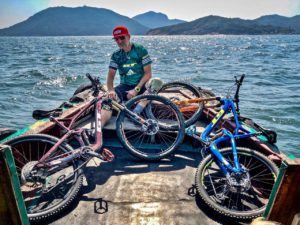 The trails meander across the island, sometimes intersecting the footpath. Once out of the jungle landscape, they opened up to views of the stunning crystalline waters, passing through a few villages, most just a smattering of houses. Hans and Martin picked up extra riders along the way; the locals were excited to mountain bike with these pros as they rode the dirt towards Sha Po Old Village.
The trails meander across the island, sometimes intersecting the footpath. Once out of the jungle landscape, they opened up to views of the stunning crystalline waters, passing through a few villages, most just a smattering of houses. Hans and Martin picked up extra riders along the way; the locals were excited to mountain bike with these pros as they rode the dirt towards Sha Po Old Village.
This is the thing with the conurbation of Hong Kong; there are towns and districts that once upon a time were truly separate, but over decades, they have merged ever closer together so that the physical borders are harder to define. But each has its own character, a personality, most honor the old and welcome the new; no matter where you are in Hong Kong, you are never far from intensely beautiful nature and unspoiled landscape that is there waiting to be enjoyed.
The light was fading as a boat came into the ferry port, multiple people in business suits disembarked, grabbed their bikes from racks and pedaled home, it was an incongruous sight, all these professionals peddling away on mass instead of driving luxury cars. This island is very popular with expats, very laid back with a hippie vibe, peaceful and free from the chaos of a million cars. With regular boat service and a 20-minute crossing, this makes commuting very appealing. It was here on the other side of the island that we would take a ferry back to Hong Kong Island leaving this quiet little paradise behind. But first it was time to take a moment, grab a beer, cheers another great Trans Urban Adventure and watch the blood orange sun lazily descend on the horizon before melting into the South China Sea and leaving us with a golden glow.
Photo Gallery
Useful websites.
Mountain Bike Hong Kong www.mtbhk.com for guiding, coaching & skills.
(Designers and builders of many of HK trails.) www.dirtraction.com
Hong Kong Mountain Bike Association www.hkmba.org










